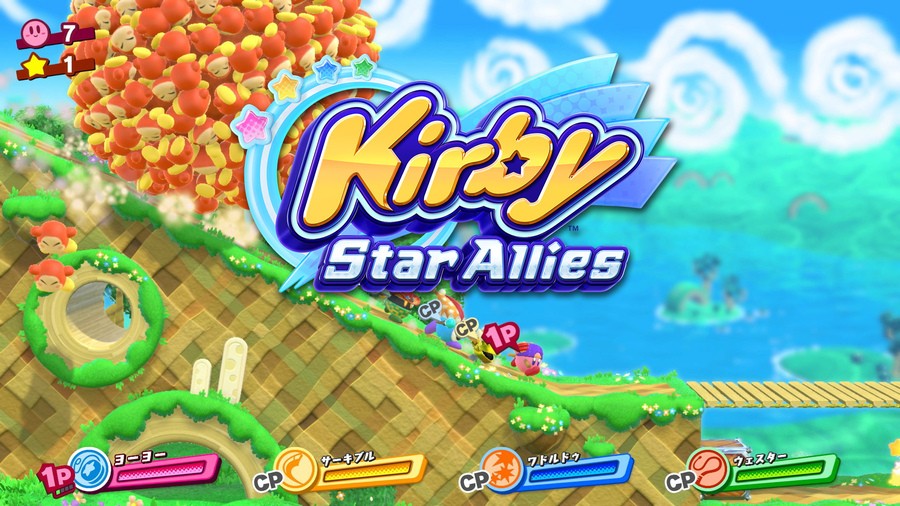
The upcoming Kirby Star Allies marks a triumphant return to 2D platforming for everyone's favourite inflatable pink ball, so we figured it was high time we had a good long look at the franchise to see just how far it's come.
Kirby's adventures started all the way back in the early nineties on the Game Boy, and his latest adventure is out this year on Nintendo Switch. That's over 25 years of inhaling enemies, stealing their abilities, and battling King Dedede.
In this feature, we're going to take a look at each mainline entry in the Kirby series to learn where he came from, what's changed over the years, and how it all ties together in Kirby Star Allies.
Kirby's Dream Land, 1992 - Game Boy
Did you know Kirby hasn't always been able to copy his enemy's abilities? In the very first game, 1992's Kirby's Dream Land for the Game Boy, Kirby could only inhale, swallow, or spit out his enemies. Kirby could pick up food that would bestow a variety of power ups though, and these acted in a similar manner to his present range of abilities. There was a spicy curry that gave him fiery breath, a mint leaf that let him shoot more air puffs while flying, and more besides.
Other than that, Kirby's Dream Land plays remarkably similar to modern day Kirby. You run and jump your way through 2D side-scrolling levels, inhaling enemies to spit them out as projectiles at others. You can fly as well by inhaling air, though firing it out as a projectile ends the flight. Complete a level and you had to face a boss, some of which you'll recognise from later games like Whispy Woods and King Dedede.
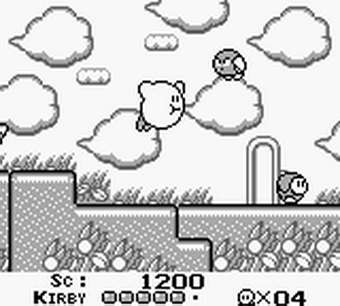
Kirby's most notable feature, at least in the beginning, was its accessibility. Designer Masahiro Sakurai wanted to create an action platformer that was easy to pick up and play, and it shows as Kirby's Dream Land was very different to other platformers at the time.
For a start, the levels are made up of a series of smaller rooms rather than long corridors. If you died, you'd start at the beginning of the room, losing only a fraction of the time you would have had the area been larger. Also, being able to swallow and fire enemies as projectiles keeps you at a relatively safe distance over, say, jumping on their heads. Challenge was there for those who wanted it though. Complete the game and you unlocked two codes that allowed you to edit Kirby's maximum HP and number of starting lives on your next play through, or start again on a mode with higher difficulty.
Interesting trivia: Kirby's design as a simple ball with eyes, a mouth, and feet was originally a placeholder, but the designers and Sakurai ended up loving it so much that they decided to keep Kirby like that. Sakurai particularly liked how Kirby's design mimicked the simplicity of the game play.
Kirby's Adventure, 1993 - NES
Kirby's Adventure launched on the NES less than a year after Kirby's Dream Land, and introduced Kirby's copy ability – along with a bunch of others he can still use today. These include the dash and sliding kick. Returning elements include adversaries like King Dedede and Whispy Woods, the Dream Land setting, and Kirby's abilities to inhale, fly, and fire projectiles.
Designer Sakurai once again led development, and aimed to tackle fan feedback from Kirby's Dream Land, with many feeling that it was too easy, and too short. Sakurai wanted to retain the simplicity of the original in the sequel, but also try and ensure that it was more appealing to those looking for a challenge. Copy abilities were the result, providing a bunch more ways to play than in its predecessor. You could now tackle each level a variety of different ways, depending on the copy ability you had equipped at the time.
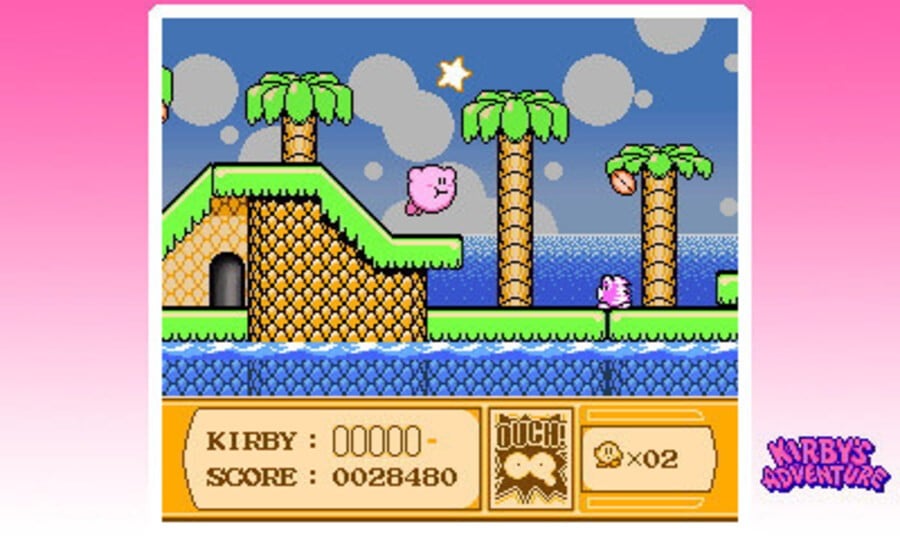
Kirby's Adventure is much longer than the original as well, with seven worlds to conquer and up to five levels and a boss fight in each of them. There's a bunch of mini games to play through as well, extending the adventure considerably.
It was also designed with replayability in mind, thanks to the random nature of the copy abilities. It's safe to say that Sakurai listened to the feedback that Dream Land was too short. Kirby's Adventure is perhaps most notable for pushing the NES's graphical capabilities to the absolute limit, with visuals so stunning you'd be forgiven for mistaking it for an SNES title – for shame! This beauty is both down to its late release in the NES life cycle, and Sakurai and Miyamoto's decision to have an artist design the backgrounds, rather than the traditional method of using a designer that specialises in game maps.
Interesting trivia: Meta Knight made his debut appearance in Kirby's Adventure as one of King Dedede's henchmen.
Kirby: Nightmare in Dream Land, 2002 - Game Boy Advance
Kirby's Adventure was later remade for the Game Boy Advance as Kirby: Nightmare in Dream Land. This was to celebrate the 10 years that had passed since Kirby's Dream Land first launched on the Game Boy.
The remake featured enhanced visuals and sound, and even featured up to four player multiplayer. The other players would play as different coloured Kirbys. You could also play as Meta Knight in the sub-game, Meta Knightmare. Here you had to complete all of the levels in the game in one sitting as quickly as possible.
Interesting trivia: 120 Kirbys rush across the screen when you turn it on.
Kirby's Pinball Land, 1993 - Game Boy
With Kirby's Pinball Land, HAL Laboratory threw out the rule book and just made a straight up pinball game featuring the pink ball. That's probably Kirby's biggest problem – being a pink ball means he can be exploited and used in any ball related game. Maybe we'll see Kirby's Football Land next?
Anyway, Kirby's Pinball Land did include features from the previous two Kirby games. The levels were themed on previous levels like Whispy Woods, you could fire Kirby into enemies to defeat them, and if you successfully managed to make it to the top of the level, you'd face a boss.
Certain items also made a return, like the Maxim Tomato, and you could find secret mini-games hidden throughout each level.
Interesting trivia: Kirby's Pinball Land later reappeared as mini-game "Kirby Brawlball" in Kirby Mass Attack. Though not entirely the same, it's clear that the developers drew enormous inspiration from the Game Boy original.
Kirby's Dream Course, 1994 - SNES
Remember what we said about Kirby being exploited? In Kirby's Dream Course he was used as the ball once again in this highly bizarre golf game. You have to hit Kirby around a variety of golf courses, taking out enemies and gathering stars.
Curiously, the copy ability makes a return here. You can copy various abilities from enemies to progress in the various courses. These include the parasol, UFO, and a sparkly ball. Once you've defeat all of the enemies on a course, the final enemy turns into a hole that Kirby must fall through to complete the course.
Interesting trivia: Kirby's Dream Course is included in the Nintendo Classic Mini: SNES library of games.
Kirby's Avalanche, 1995 - SNES
Kirby's Avalanche wasn't actually a Kirby game at all. It was the Japanese title Super Poyo Poyo hiding under the Kirby guise to better appeal to western gamers. The only changes made for the western release was a Kirby skin for the various characters.
Interesting trivia: The only notable feature for Kirby fans in Kirby's Avalanche is that it revealed Meta Knight's true name (Meta Knight!) and changed his appearance to the one we know and love today.
Kirby's Dream Land 2, 1995 - Game Boy
Kirby then returned to Game Boy with a direct sequel to his debut game, Kirby's Dream Land 2. It played much like the original, but with the inclusion of swimming sections and, most notably, three animal friends that Kirby can ride to help him on his adventure. These animals basically help Kirby travel faster in difficult environments. Rick the Hamster doesn't slip on ice, Coo the Owl can fly at full speed through harsh winds, and Kine the Ocean Sunfish can swim against the current. All animal companions generally travel faster as well, speeding up the adventure.
The copy ability from Kirby's Adventure also makes a return here. Curiously, your abilities change depending on the animal companion you're riding at the time.
Interesting trivia: Kirby's Dream Land 2 supported the Super Game Boy, and had a limited colour palette and additional sound effects when played through an SNES.
Kirby's Block Ball, 1995 - Game Boy
Kirby's Block Ball is a Breakout-like adventure that launched on the Game Boy in At this point, we're starting to wonder if there's a ball-related game that hasn't been turned into a Kirby game.
Much like Kirby's Pinball, the only real Kirby-related feature of note was the return of the clone ability. Kirby could take on a variety of different forms to break through different blocks.
Having said that, Kirby's Block Ball was praised at the time for being an accessible version of Breakout that anyone could enjoy. That's absolutely in the spirit of Kirby!
Interesting trivia: Though the instruction booklet for Kirby's Block Ball depicted Waddle Doo and Pengi, neither character actually appears in the game.
Kirby Super Star, 1996 - SNES
Kirby Super Star was something of a departure for the franchise. It launched towards the end of the SNES's lifecycle and was more a collection of smaller games than a full on platforming adventure. This entry did introduce multiplayer into the mix though. You could play all of these games with a friend, with the second player taking control of a helper character.
What's interesting here is that the first player would have to first steal an ability from an enemy, and then turn that ability into a helper character that the second would then control. Kirby can enlist the support of a helper character even in single player too, with the computer taking control.
If the helper character dies, Kirby then has a short space of time to find another ability for the helper character. The reason for this new format, as a collection of games rather than a single adventure, was because Sakurai felt like games during the 16-bit era had become too long. In keeping with Kirby's simplistic philosophy, Sakurai decided to develop this Kirby as a collection of games so you could reach a conclusion to each faster.
Interesting trivia: "Spring Breeze", one of the seven campaigns included in Kirby Super Star, is actually a remake of the original Game Boy game, Kirby's Dream Land.
Kirby Super Star Ultra, 2008 - DS
Kirby Super Star Ultra is an enhanced remake of Super Star, which launched in 2008 on the Nintendo DS. It had improved visuals and sound, and a variety of new modes and sub-games.
Interesting trivia: Beat Meta Knightmare Ultra, and you may witness a Meta Knight version of the intro.
Kirby's Star Stacker, 1997 - Game Boy
Kirby's Star Stacker is the Kirby take on Tetris. Three different blocks fall from the top of the screen, each depicting an animal friend from Kirby's Dream Land 2. Your goal is to sandwich the stars on the game board between two identical blocks to grab them, earning points. Much like in Tetris, you fail if the blocks build to the top of the screen.
Much like with Kirby's Pinball Land and Kirby's Block Ball, Star Stacker doesn't contain an awful lot of Kirby elements. Instead, it provides a nice and simplistic version of a game that already exists – in this case, Tetris.
Interesting trivia: Kirby's Star Stacker was later re-released in Japan for the Super Famicom as "Kirby no Kirakira Kizzu", but never released in the US or EU because Nintendo of America stopped shipping SNES games in 1997.
Kirby's Dream Land 3, 1997 - SNES
Kirby's Dream Land 3 was the final title Nintendo released for the SNES, and is a direct sequel to Kirby's Dream Land 2 on the Game Boy. This entry is notable for being the first Kirby title to have plot continuation with a previous entry. Aside from that, there were no new features of particular note. Kirby could summon his friend Goo, who would accompany Kirby on his adventure in exchange for two hit points. Goo was either controlled by the computer, or by a second player.
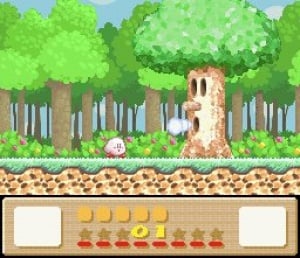
The three animal friends from Kirby's Dream Land 2 also returned, along with three new friends with additional abilities.
Interesting trivia: Kirby's Dream Land 3 didn't actually release outside of Japan or North America at launch, and wouldn't be playable in those regions until its re-release on the Nintendo Wii.
Kirby 64: The Crystal Shards, 2000 - N64
Kirby 64: The Crystal Shards was, again, a direct follow up to the previous entry, Kirby's Dream Land 3. It's most notable for its use of 2.5D visuals, and was the first entry in the Kirby franchise to do so thanks to being released on the 3D-capable N64.
In terms of gameplay, the biggest new feature here was the ability to combine any two copied abilities for additional effects. You could combine two of the same for a stronger effect, or two different to make a completely new effect. An example of this is the Bomb and Cutter combo that produces a shuriken that explodes on impact when thrown.
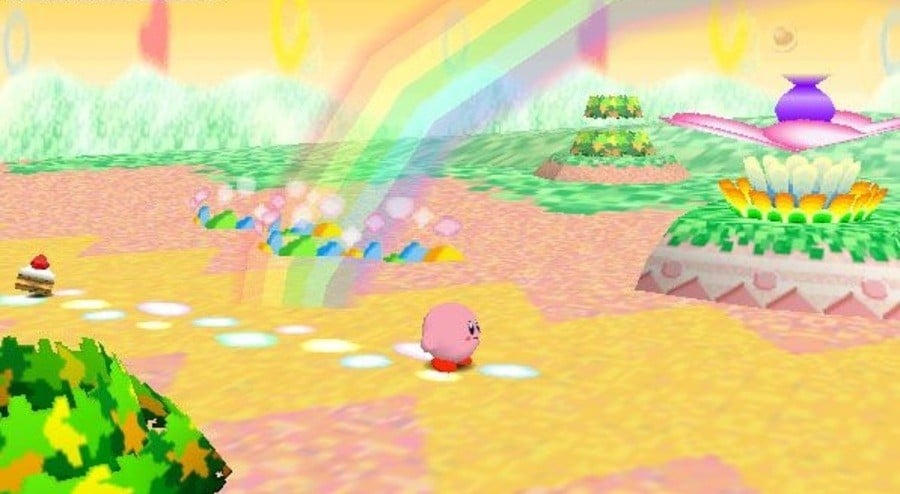
While multiplayer didn't return in the main campaign, you could play a selection of mini-games with up to three friends – a first for the franchise, which had previously supported two players maximum. There were three mini-games in total, and your friends could play as Waddle Dee, Adeleine, and King Dedede.
Interesting trivia: In early screenshots of Kirby 64, King Dedede, Waddle Dee, and Adeleine were all shown as playable characters in the main game. This could also have suggested that Kirby 64 may have at one stage been developed as a four player game, though this was never confirmed.
Kirby Tilt 'n' Tumble, 2000 - Game Boy Color
Kirby Tilt 'n' Tumble was a puzzle game in which you actually tilted your Game Boy Color to direct Kirby around a variety of levels. The goal was to grab all of the stars in each level, while avoiding obstacles. You could quickly jerk the Game Boy Color in any direction to cause Kirby to jump that way.
This entry is notable for including an accelerometer inside the cartridge itself, giving the game extra functionality.
Interesting trivia: If you pause the game and wait a few seconds, Kirby falls asleep. If you then shake the Game Boy Color, Kirby will wake up with a start before falling asleep again.
Kirby Air Ride, 2003 - GameCube
Kirby Air Ride is a racing game, and curiously the only Kirby game to launch on the GameCube! You ride vehicles based on previous Kirby games, like the Warp Star, though the vehicle moves by itself, so you only have to control its direction. This is likely a deliberate design decision to make Kirby Air Ride more simplistic than other racers like Mario Kart: Double Dash.
The most notable Kirby feature is copy abilities. You can suck up nearby enemies to copy their ability, then use it to hinder your opponents or help yourself. You can also glide in certain areas, and it acts much the same as when flying in other Kirby titles.
At the beginning, Kirby is the only playable character, though there is multiplayer, with the other players taking the role of a different coloured Kirby. You can unlock Meta Knight and King Dedede as playable characters though, and they act differently from Kirby.
Interesting trivia: Following the release of Kirby Air Ride, Kirby creator Masahiro Sakurai resigned from HAL Laboratory.
Kirby & The Amazing Mirror, 2004 - GBA
Kirby & The Amazing Mirror launched on Game Boy Advance in 2004, and was the first entry in the franchise to feature four player co-operative multiplayer. Kirby has a cellphone that he can use to call in any nearby player that has a GBA and a copy of The Amazing Mirror in it. Much like in previous additions, these three other players can also be controlled by the computer.
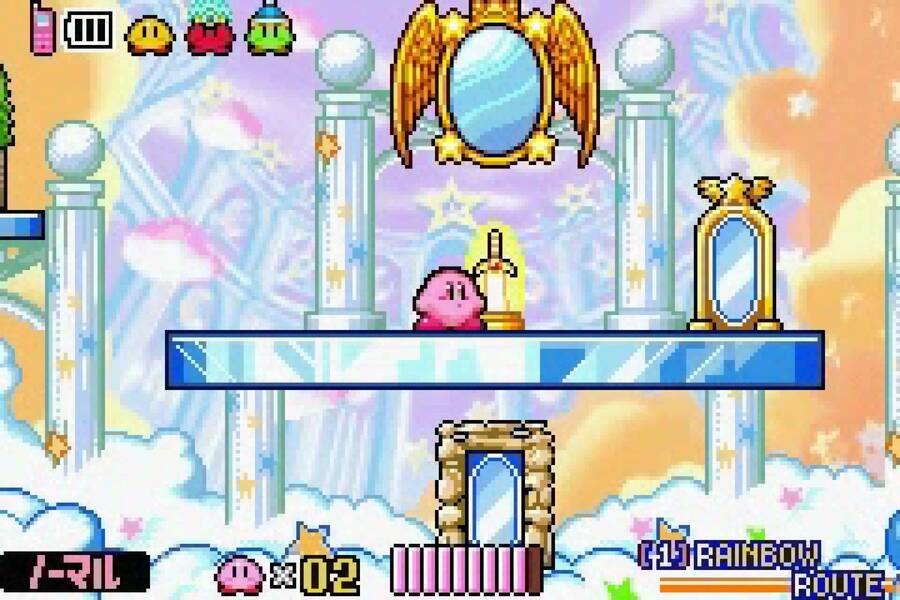
This entry is most notable for playing like a metroidvania, rather than a traditional platformer. Kirby is trapped in a maze and has to find his way out by copying abilities from his enemies that let him progress in specific areas. You can progress in any order you wish, though you have to complete each section to reach the final boss.
Kirby & The Amazing Mirror also introduced several new abilities, like Cupid, which allows Kirby to fly and fire arrows from a bow, and Smash, which gives Kirby the same abilities as he has in Super Smash Bros. Melee, amongst many more.
Interesting trivia: Kirby & The Amazing Mirror somewhat ironically doesn't contain the "Mirror" ability.
Kirby: Canvas Curse, 2005 - DS
Kirby: Canvas Curse (AKA Kirby: Power Paintbrush in Europe) probably shouldn't be on this list. It isn't a traditional Kirby game and doesn't really include much platforming of note.
It was the first Kirby to launch on DS, and was fully controlled using the stylus. You have to paint paths for Kirby to traverse using the stylus, and can tap on Kirby to dash and his enemies to stun them. If Kirby defeats a stunned enemy, he can pick up an ability that you can then use by tapping Kirby.
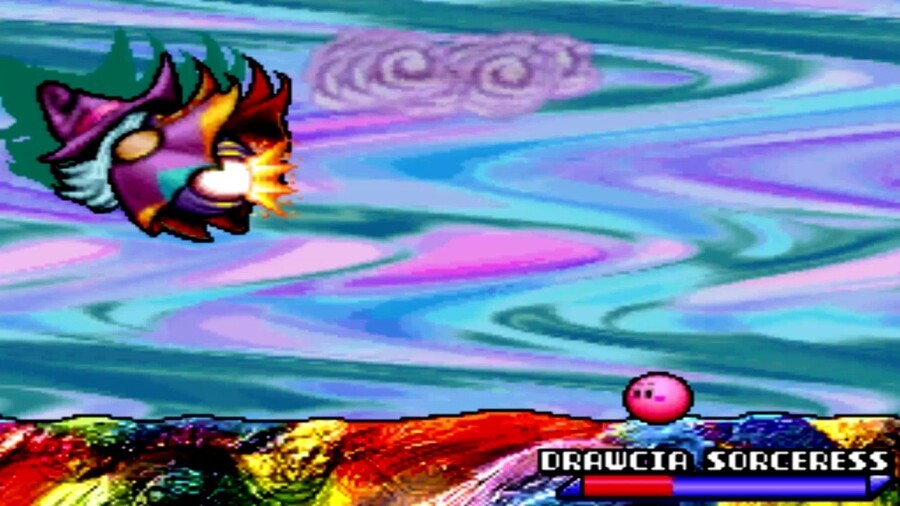
Kirby: Canvas Curse didn't produce any new features that would be used again in any other entry of the franchise (except one, which we'll get to later). We included it because, despite this, it does count as a mainline entry and it felt mean not to.
Interesting trivia: Kirby: Canvas Curse was entitled "Touch! Kirby" in Japan, which is a much better (and more self explanatory) name if you ask us.
Kirby: Squeak Squad, 2006 - DS
Kirby: Squeak Squad launched just a year after Canvas Curse, and marked a return to 2D platforming for Kirby. This entry is notable for introducing environments that react to Kirby's abilities, like grass that you can cut and ice that you can melt to progress.
Kirby can also store multiple abilities in his stomach, and you can combine several of these using the touch screen to create new abilities. This is similar to the system used in The Crystal Shards, but on a much smaller scale as you can only combine certain abilities.

Also introduced in Squeak Squad was Ability Scrolls, which you can use to power up any ability you currently have equipped. Again, this is similar to a system in The Crystal Shards, that let you combine two of the same abilities to increase its power. An example of this in Squeak Squad is the hammer growing to twice its normal size. You can also store items in Kirby's stomach and combine them to increase their power. You can combine food to restore HP, or stars to shoot out more powerful projectiles.
Interesting trivia: Kirby: Squeak Squad will wish you a happy birthday on your birthday if entered into the DS. Cute!
Kirby's Epic Yarn, 2010 - Wii
Kirby's Epic Yarn launched on the Wii in 2010, and once again was a complete departure from the usual gameplay we'd come to expect from the franchise. As the name suggests, the entire theme is based on knitting and the world design reflects that. It appears to be made up of a variety of fabrics knitted together.
This is also reflected in the gameplay. Kirby doesn't inhale enemies like before, but instead whips them with a piece of yarn, bundles them into a ball, and fires them at other enemies. You can't copy abilities in Epic Yarn either, though Kirby does transform into different shapes depending on the circumstances.
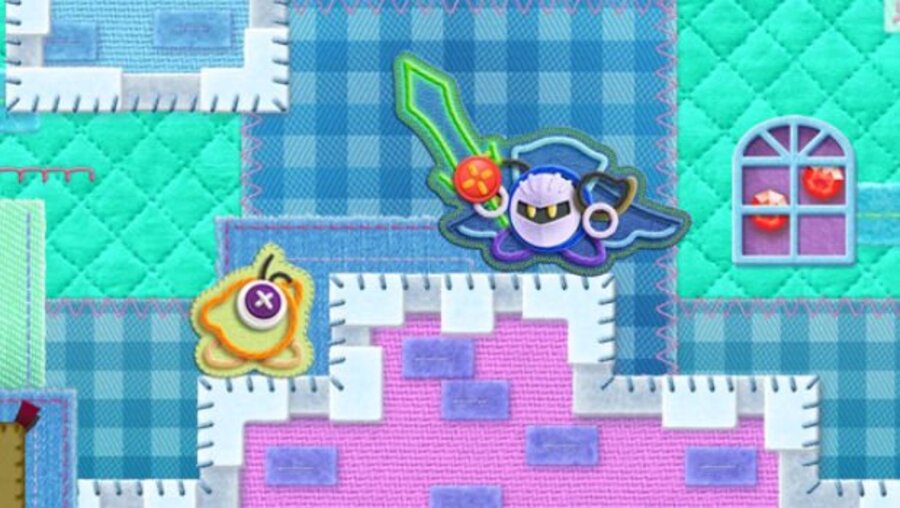
For example, Kirby doesn't fly but instead transforms into a parachute to glide to the ground. Similarly, he turns into a knitted car when dashing and a submarine when swimming through water. There are many more unique transformations that only appear during certain sequences in the game too. Multiplayer also makes a return, though it's limited to two players. The second player takes charge of Prince Fluff, who behaves in exactly the same manner as Kirby.
Interesting trivia: Epic Yarn wasn't originally conceived as a Kirby game. Prince Fluff was the protagonist and it was called World of Fluff.
Kirby Mass Attack, 2011 - DS
Kirby Mass Attack seems more inspired by Pikmin than other Kirby titles. It's basically a strategy game in which you indirectly control up to 10 Kirbys on the screen by tapping where you'd like them to go. Tap on an object and they'll interact with it, including defeating enemies. You can even flick the screen to fling the Kirbys around. You gain more Kirbys by grabbing fruit dotted around each level.
Interesting trivia: You can fish King Dedede out of the water in the fishing mini-game, and he's the most difficult object to reel in.
Kirby's Return to Dream Land, 2011 - Wii
Kirby's Return to Dream Land was a triumphant return to the 2.5D visuals and gameplay of Kirby 64: The Crystal Shards. Return to Dream Land took it a step further though, and introduced four player multiplayer into the mix for the entire campaign. Other players can either take on the role of a different coloured Kirby, or play as Meta Knight, Waddle Dee, or King Dedede.
Return to Dream Land introduced a bunch of new features too. Super Inhale allows Kirby to swallow larger items by shaking the Wiimote to increase the power of his inhale, while Team Attack lets Kirby and his allies stand on top of each other and unleash a more powerful attack.
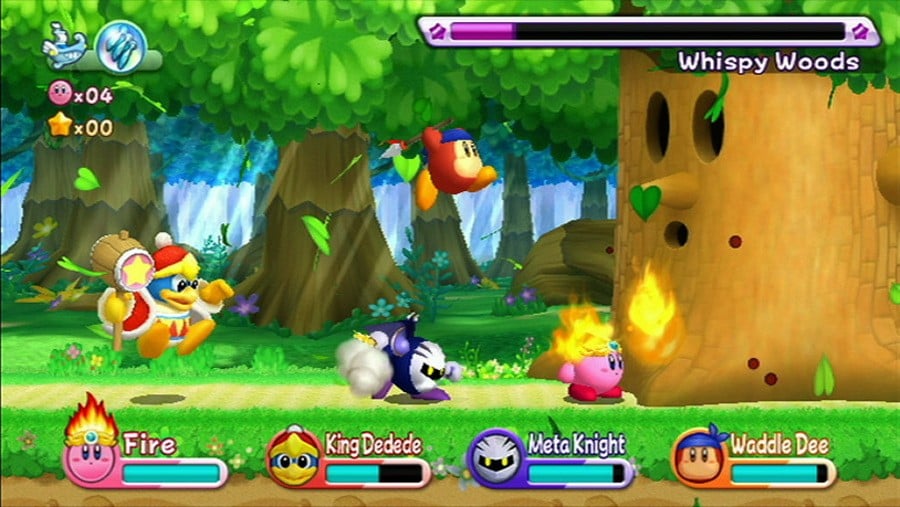
Other than that, this is traditional Kirby as you know and love him. You can inhale, float, swallow, fire projectiles as usual, and copy abilities from foes as usual. Occasionally, you'll find a super ability that bestows a temporary ability much more powerful than the typical ones.
Interesting trivia: Kirby's Return to Dream Land began development as a GameCube title first shown at E3 2005, but went through so many iterations it didn't actually arrive until 2011 on the Wii.
Kirby's Dream Collection, 2012 - Wii
Kirby's Dream Collection was released on the Nintendo Wii in 2012, and is an anthology of six previous Kirby games. It includes:
- Kirby's Dream Land
- Kirby's Adventure
- Kirby's Dream Land 2
- Kirby Super Star
- Kirby's Dream Land 3
- Kirby 64: The Crystal Shards
Interesting trivia: Kirby's Dream Collection only launched in Japan and North America, skipping Europe entirely.
Kirby: Triple Deluxe, 2014 - 3DS
Kirby: Triple Deluxe follows closely in the footsteps of Return to Dream Land, though makes a few alterations. The 2.5D visuals remain, as do most of Kirby's abilities. Super Inhale does return, though in a different form. This time you have to pick up a Miracle Fruit to turn into Hypernova Kirby, allowing you to inhale much bigger items than usual. There's also a bunch of new copy abilities, like Beetle, Archer, and Circus.
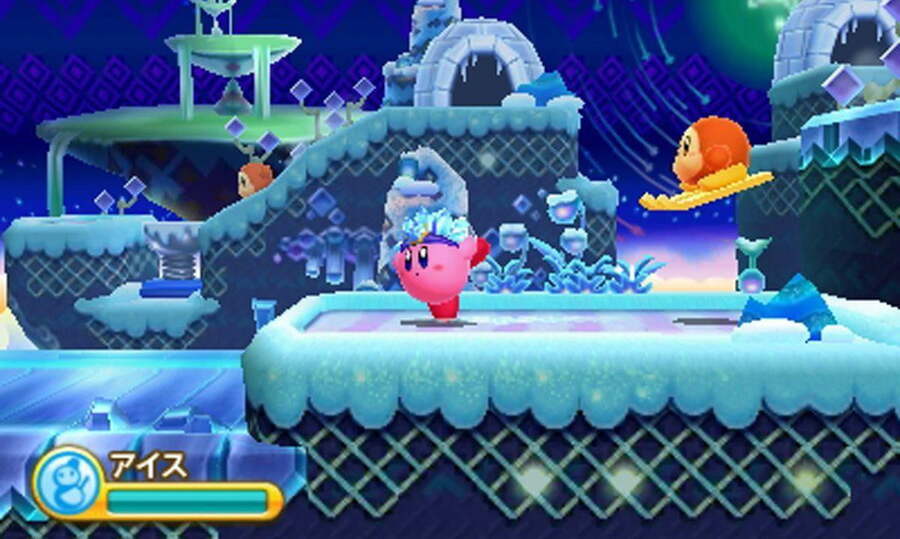
Triple Deluxe is notable for using the 3DS's 3D effects, allowing attacks to arrive from both the foreground and background, though it does take a pretty sizeable backwards step by removing multiplayer from the single player campaign entirely. There are mini-games that allow multiplayer though.
Interesting trivia: The first letter of each of the levels combine to spell the word "flowered", which is the final form of the final boss.
Kirby and the Rainbow Curse, 2015 - Wii U
Kirby and the Rainbow Curse (or Rainbow Paintbrush in PAL regions) is a direct sequel to Canvas Curse on the DS, and contains very similar gameplay. Much like the DS iteration, here you paint paths on the Wii U gamepad using the stylus, which Kirby then travels across. You can also tap Kirby to make him dash, like before.
Rainbow Curse also allows Kirby to take on different forms in select levels, much like in Epic Yarn on the Wii. These include a tank, submarine, and rocket, and you also control all of them using the stylus. It also has an interesting art style, much like Epic Yarn, though this one is inspired by claymation.
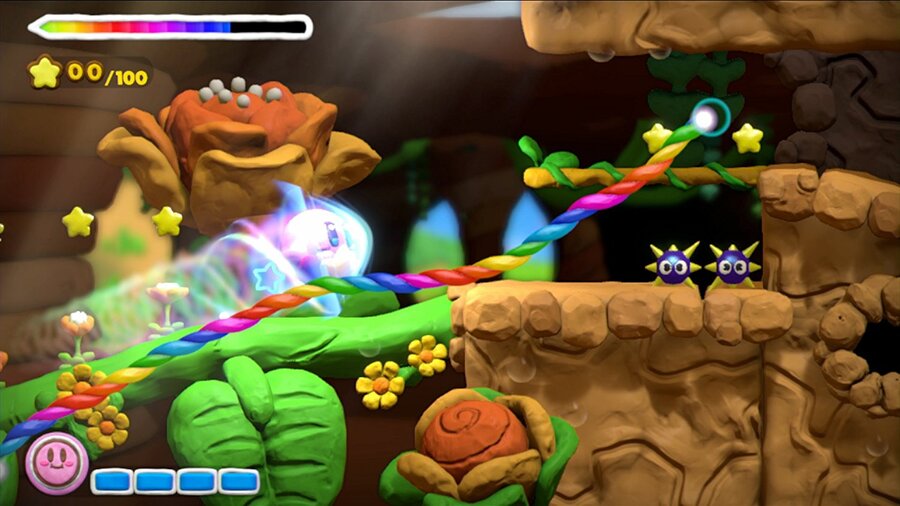
Four player multiplayer makes a return too, though it does make the game insanely easy. The three other players play as Waddle Dees, and they can carry Kirby around and throw spears at enemies. Rainbow Curse is also the first Kirby game to feature amiibo support. You can use Kirby, King Dedede, and Meta Knight to active various in-game bonuses.
Interesting trivia: A bandage appears on Kirby's head when he only has one health remaining.
Kirby: Planet Robobot, 2016 - 3DS
Kirby: Planet Robobot plays very similarly to Triple Deluxe, using the 3D effect of the 3DS to allow Kirby to travel between two different planes – the background and the foreground. New additions include three copy abilities: Poison, Doctor, and ESP, a mech suit called Robobot Armour that increases Kirby's power, and two new bonus mini-games.
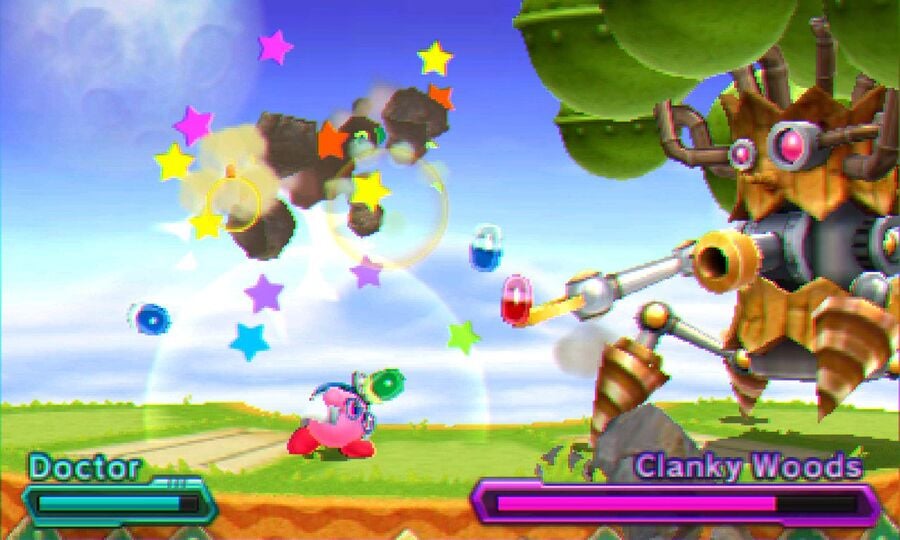
The Robobot is the biggest new feature though, allowing Kirby to destroy larger objects and enemies than before. It can also gain copy abilities just like Kirby, and you can customise it with a variety of unlockable stickers.
Interesting trivia: The ROM of Kirby: Planet Robobot was leaked on Reddit just prior to its release.
Kirby Battle Royale, 2017 - 3DS
Kirby Battle Royale is a top down brawler that launched on the 3DS in 2017. You have to help Kirby battle other Kirbys in a variety of arenas, using traditional Kirby abilities to give you the upper hand in combat.
Interesting trivia: It is possible for a Battle Arena match to end in a tie if two Kirbys knock each other out at exactly the same moment.
Kirby Star Allies, 2018 - Nintendo Switch
Here we come full circle, with the upcoming Kirby Star Allies on Nintendo Switch. What's interesting to note about this entry, is how many features from previous Kirby games its incorporated from the previous entries. Before we get onto that though, Kirby Star Allies plays much like 2011's Return to Dream Land. It's designed with four player co-operative multiplayer in mind, and has you beating platforming stages with Kirby and his allies working in tandem.

Kirby's moveset is pretty much the same as 1992's Kirby's Dream Land, though with the copy ability, dash, and sliding kick of Kirby's Adventure. Certain animal friends, first introduced in Dream Land 2, also make an appearance, and you can ride on your allies much like you did the animal friends.
Multiplayer works much in the same manner as Super Star, with friends taking the role of helper characters that can also be controlled by the computer, the visuals are 2.5D, much like in Kirby 64: The Crystal Shards, and you can combine certain abilities with elements, just like in both The Crystal Shards and Squeak Squad. amiibo support also returns from Planet Robobot.
So as you can probably tell by now, Kirby Star Allies really is the latest major instalment in the Kirby franchise, with many returning, or at least tweaked, features from many of the previous iterations in the franchise. We hope you're as psyched to play it as we are!





Comments 69
Personally didn't really liked the demo.
Looks ok but for me too chaotic and kind of plays by itself
Kirby 64 is the only Kirby game that i got for the original console, until Star Allies.
i do have some of the Kirby games as VC, (64, SNES game, and GB Color.)
can't wait to try out this one next friday.
I'm not really psyched and don't expect it to sell very well. It looks really easy and is from various accounts. I've seen several videos of Kirby winning boss fights by standing still and doing nothing at all. Can't say I like the 4 characters on screen and would find it distracting. Then there's the framerate. Why is it only 30fps? Kirby and the Rainbow Paintbrush on Wii U ran at 60fps. But let's go further back, I'm fairly certain that both Kirby's Epic Yarn and Return to Dream Land on Wii ran at 60fps as well.
Really loved Return to Dreamland. It had one of the best bosses I've ever fought against and AAMOF was my first Kirby game. Although I found the Switch title a little too familiar but I might pick it up. I liked the demo after all
What a sucky legacy.
Really good article, Kirby is always a great chill out game
Happy Mario Day guys:
I'm excited for this. Always been a big Kirby fan. Always enjoyed the games being easy at first, and ramping things up later. Demo was quite fun too.
Cool guide, very excited for Star Allies.
@SLIGEACH_EIRE You're trolling man.
I don’t know what people expect from a new Kirby game. It’s maintaining its purpose, to be accessible to younger players and be instantly gratifying. And it’s gorgeous. There are plenty of hard-as-balls platformers on the eShop for u to sink your prepubescent fangs into without whinging about this franchise. Shut up.
Another interesting fact for Kirby's Dream Collection, the Japanese version has a comic viewer but lacks the music video the US version has.
At least interesting to me, that would have been great to notice back in 2011 and be like "this is just like Sonic Mega Collection!" It even has its own music for the viewer, which I'm not entirely sure if the US version used at all for anything.
@retro_player_22 You're too late, it was yesterday. Don't worry about it, Nintendo forgot as well.
"Kirby your enthusiasm". Nice, as a fan of the show I've never thought of that before, good job!
Great article by the way. Very comprehensive. Planet Robobot is my favourite of the ones I've played, it's just so much fun!
I don't care if it's easy. It's a Kirby game, and it looks perfect for local multiplayer with the kids.
However, I've heard that the demo feels like sub-30 fps, which I hope is ironed out in time for the full release.
I wish Nintendo would give Kirby a break. I’d love to see a new Wario Land side scroller
@KingdomHeartsFan That wasn’t directed exactly at u, sry. I’ve heard major complaining elsewhere and maybe vented a little too much here. But Kirby isn’t for everyone. I get that.
"The upcoming Kirby Star Allies marks a triumphant return to 2D platforming"
What? Most of the Kirby games of the last couple of years have been 2D platformers.
I'm excited for Star Allies, despite all the criticisms the game recieved. It's not even out yet, and from what I played in the demo the allies are completely optional outside of specific puzzles, but even then they usually spawn in enough enemies for you to solve it.
After playing through Bayonetta 1 + 2, all I need right now is a cute and easy game like Kirby.
First played Kirby's Adventure at a friend's house in 1995, along with Contra. Loved it. When I read in Nintendo Power that Kirby Superstar was coming out, I begged my parents for it. In 1996 a few months after it came out, I got it and it was great.
I didn't get a new Kirby game until Kirby's Return to Dreamland came out on the Wii-great. This was followed by Kirby's Dream Collection which finally let me play the origins of the franchise. On my 3DS I grabbed up the adorable Kirby Pinball. I now after playing the demo am looking forward to friday for another great Kirby game.
@retro_player_22
Love day was yesterday moron.
As a dad gamer, I find these games to be perfect to play with my 8 year old son. We love Kirby games and the fact that they are easy presents a great opportunity to play the entire game all the way through to the end and beat it together. We are very much looking forward to this one since we love Return to Dreamland so much. Bring on more Kirby!
Where is Blowout Blast?
Nice list! I've been wanting to go through most Kirby's past games since I've never beaten one, this list helps trim the list because there are so many games
@LUIGITORNADO I don’t know why it’s dormant. Remember this article?
https://www.nintendolife.com/news/2014/11/dear_nintendo_please_let_the_next_wario_land_title_look_as_gorgeous_as_this
I've been playing games since 1984ish and don't think I've ever played a Kirby game. It's shocking really.
Wow, Kirby's taken more twists and turns than I ever realized. I played later games like Squeak Squad, and I'm in the middle of Mass Attack, but I never noticed all of the additions taken in and out, or even the weirder turns the series can take like with Kirby's Mean Bean Machine Sort of like Mario with a good core series, but a bit more unconventional with side games.
On Star Allies, I don't think I'll be getting it JUST yet, but not because I'm not interested. I've avoided spoilers, but I'm sure my personal gripe will be solved. I felt the levels were just too short, but that's never been a problem in the main series, so I figure it's mainly just for areas with boss fights, as opposed to just corridors with power-ups in them, which is cool.
The main reason I'm avoiding it is that I want to try waiting until I can grab an extra set of Joy-Cons, and some people I can play it with consistently. I had some fun with the AI (they were competent, but still got damaged just enough that you need to keep an eye on them without babying them) but despite being a one player guy, Switch has me itching to try out multiplayer, and this Kirby game perfect for some drop-in gameplay.
That, and i don't have a ton of cash, but... I'm trying to work out my budget... trying (throws sheet over Detective Pikachu game/amiibo pre-orders)
Good write up! Kirby is my favorite gaming series of all time and it makes me happy to see this series get some more recognition and attention. Nightmare in Dreamland is my personal favorite with robobot and super star ultra not too far behind. I'm going to drop some more fun facts too
Nightmare in Dreamland also a rendition of fountain of dreams when you fight king dedede most likely based of the melee rendition of the same song. The game also unfortunately lacks the secret hal room that was included in the original game
Dreamland 2,3, and Crystal shards form a narrative trilogy known as the dark matter trilogy. These 3 games were primarily directed by a man known as Shinichi Shimomura. After the release of nightmare in dreamland (the last game he was credited in) he seemingly left hal. It's rumoured that he passed away back in 03 but no one knows for sure.
Super star ultra is also notable for including kabula as a boss fight after he was unfortunately cut for the original release of kirby super star
In nightmare in dreamland / adventure the first letter of each level when combined and placed in reverse level order spell out roygbiv
Lastly in return to Dreamland as well as planet robobot the first letter of each level combine to spell out "crowned" and "program" respectively which are allusions to the final boss of each game.
@KingdomHeartsFan Aaaha, ahaaaaaa. No.
I played the Switch demo last weekend briefly, it just didn't really click, great visuals but it felt just a bit too autopilot to me. Maybe I needed to give it a bit more time. Then again Mario Odyssey didn't really start to click with me until I approached the final stages of the main game.
Got nothing against Kirby at all, but I think I'll wait until I can pick this up for around £20-£30.
Played the demo and for some reason it just didn't click with me.
Ironically though, one of my all time favourite games is Kirbys Dreamland on the Game Boy that I got from Toysru's, Christmas 1992
i think i still have my gameboy cart.
and my super gameboy. what a world THAT was.
@LUIGITORNADO Another Wario Land side scroller would be awesome. Wario Land 3 on the GBC still remains my favourite.
Thank you for such a comprehensive list.
Didn't think I was much of a Kirby Fan until I realised I've played most games on the list. Have even spent more than 7 hours just on Kirby Star Stacker! It's so addictive!
Would really like to get my hands on Kirby Air Ride but it seems to be ridiculously expensive!
Still waiting for the day we get a 3d platformer Kirby game.... Only been waiting since Mario 64 first launched.
@amishpyrate Now that would be interesting!
Kirby is a series I have largely passed over over the years. But not because I have anything against it. I just usually end up not playing it for one reason or another. Often a perceived multi-player focus makes me see the series as secondary interest because for most of my life before and after college I have rarely had easy access to friends who also game.
@mailman article seems to have a slight bias against the latter spin-off games (most notably in the comment about almost not including the first DS game as it’s not a proper platformer, despite including Star Stacker and Avalanche, which have almost zero Kirby relevance).
I like Adventure and SuperStar a lot, but no other Kirby game has gripped me as much as Canvas Curse. Rainbow Curse wasn’t near as good. Can’t say I enjoyed the demo of the Switch game much. Too much multiplayer focus.
Haven't played a Kirby game in years. The series has lost its magic for me. And from what I've heard about the recent installment, the game plays itself. If there is no challenge then I'm not interested.
I like Kirby as a character, and one or two of the old games but that's it... The games are quite slow and all and the new one star allies looks boring and the game plays itself and people are reporting bosses can be beat by doing nothing... I won't be buying it in it is under £20 lol
@mailman Sadly I had to sell my Wii U.
@MegaVel91 "You're trolling man."
Really? That's the entirety of your contribution to this discussion? I hope that was a poor attempt at humour or perhaps you were being ironic. I wrote a paragraph on legitimate concerns and criticisms. Only for you not to address the story in any way whatsoever but instead have a pop at me.
Nobody plays Kirby games for a challenge, though. It's more that they are always fun experiences, and they are playable by kids and casuals as well.
I will definitely buy this, but not day one. I appreciate the games, but chances are I will wait for a sale.
Kirby’s dream land 2 was the very first game that I ever owned. I freaking love Kirby and I’d pick up Star Allies but I think I need to finish some of my backlog first.
this was a great read.... thanks NL! Reminds me that while I don't consider Kirby as one of my favorite franchises it has definitely had an impact on my life as I have played 95% of these during their initial release.
What did Canvas Curse do in Glens cornflakes to deserve such shade? 😆
Despite everyone saying how easy the games are I've been stuck at some point in every Kirby game I've played. 😊
Played the demo and loved it! Kirby is pure and simple fun. Plan on doing it solo and multiplayer. Also Kirby has one of the best soundtracks Nintendo can offer!
I only liked the Gameboy games. I tried to play the other ones on the virtual console but just lost interest.
I haven’t played the demo since it isn’t available in Japan, but I’m pretty confident I will like it. I don’t need nor do I want Kirby games to be difficult, there are other games for that.
Famitsu has given the game a rating of 9 out of 10, so I’m sure the game will be fun enough. After Bayonetta and Residen Evil Revelations, Kirby will be an awesome respite from difficult and bloody games.
@SLIGEACH_EIRE @Franklin Yes fakers of the internet this was yesterday but Google kept the love throughout the weekend.
The games always start off crazy easy because it's not about difficulty. For me I just personally love the music, cool themes and chill times Kirby brings to the table. Plus most games have an original villain/final boss and I love seeing what HAL can cook up next. They are surprisingly really good at coming up with legitimately sad backstories that you can only find via playing through the game's harder modes (true arena, EX mode, meta-knightmaer, etc.). The game's are easy, but there are a lot of things to catch your interest if you like depth.
PS- Planet Robobot's True Arena was brutal. Actually. It took me upwards of 15 tries to reach the secret final boss, only to lose and have to try a bunch more. Wicked challenging and fun.
I love Kirby’s Dream Course! I’ll defend it ‘til the day I die.
I love Kirby but... we’ve gotten a new game almost every year for a while. Just let him rest please haha (And use the team to create something different!) No hate, just wish they’d take about 2 years off.
Very disappointed that Star Allies is 30fps. It's one of the only Nintendo side scrollers to ever fail to run at 60fps, and it makes a world of difference. 60fps is the gold standard, which is why Nintendo usually hits it.
Never played Kirby games and definitely this won't be my first (tried the demo and everything about it is bad)
@Audiobrainiac exactly. Kirby has ALWAYS been super easy. They are a ton of fun going through though for young and old. Kirby has never been about challenge. It’s great how his popularity has grown as well. 10 years ago a Kirby game was never considered a huge release. Glad he’s more appreciated now
@Audiobrainiac you ever play warioland shake it! On the Wii. Bit of a hidden gem and I know a lot of people have never heard of it. Beautiful looking game. The animation is amazing
It's sad that almost anyone has played Kirby's Dreamland 3.
It's a pity to read in this Retrospective: "Aside from that, there were no new features of particular note."
When that's not true.
Kirby Dreamland 3 was super original when it came to collectibles. You must collect a Heart Star in each level. They are possessed by residents of Dream Land who reward Kirby with them at the end of the stage if he does them a personal favor during that level.
Every collectable was super original and very fun to guess and perform.
What an underrated Gem even by this site!
I bought the first Kirby's Dreamland game on Gameboy when it came out. I loved the game, and the soundtrack was fantastic.
Then all the shovelware and gimmick games came out (pinball, puzzles, rainbow brush, etc). I loved the demo of Triple Deluxe, but that wasn't enough to make me buy the outdated 3DS. Finally we get another non-gimmick Kirby on a console, but then there's the crappy framerate issue. Pity.
I'm also bummed that the new game has a lame orchestra soundtrack, instead of an electronic style update of the old tunes.
@Matthewxcv If you think the Kirby games have lost their magic, maybe look into Planet Robobot on 3DS. I’ve been playing Kirby games off and on since the beginning, and this one was my favorite.
I don't understand all the people complaining about Kirby being easy. Kirby has always been easy. It's a great game if are a kid, have kids, or just want something that is fun and simple to chill out with. NOT EVERYTHING IS MADE FOR YOU
@Mr_Pepperami I've heard of that! Never got to play it though. Looks great. Love the art style.
Great article about the history of Kirby.
I'm Looking forward to be playing Kirby Star Allies.
Kirby is one of those games that either stays very much the same, like the new game, or is drastically different like Rainbow Curse.
@Fandabidozi Haha! In hindsight, that does read a little harsher than I intended! I love Canvas Curse, and was more pointing out that it's not really a traditional Kirby game. But the more you dig into it, the harder it is to figure out what a real Kirby game actually is!
Great feature! Nes and 3ds versions were the best!
Nifty retrospective. Well, if you like Kirby games, then I hope this new instalment is good for you. I, however, will not be purchasing this one.
In the article they say that Kirby's return to dreamland, Triple deluxe, etc are similar to Kirby 64 because they are all 2,5D. But I personally think Kirby64 is totally different, because of the camera. It came pretty close to 3D.
Show Comments
Leave A Comment
Hold on there, you need to login to post a comment...